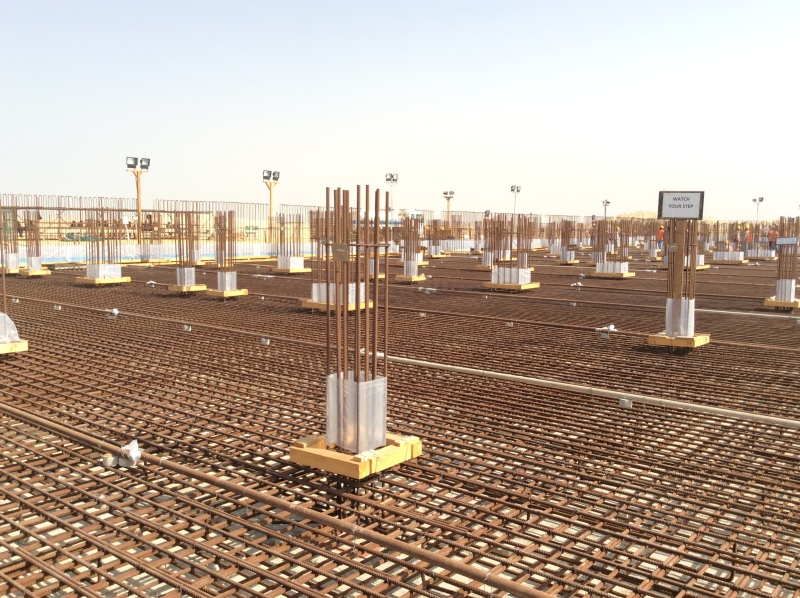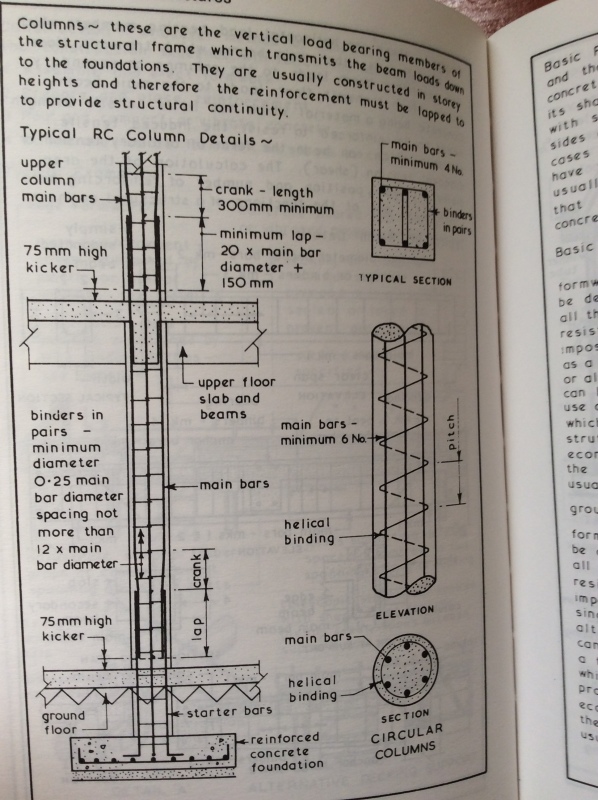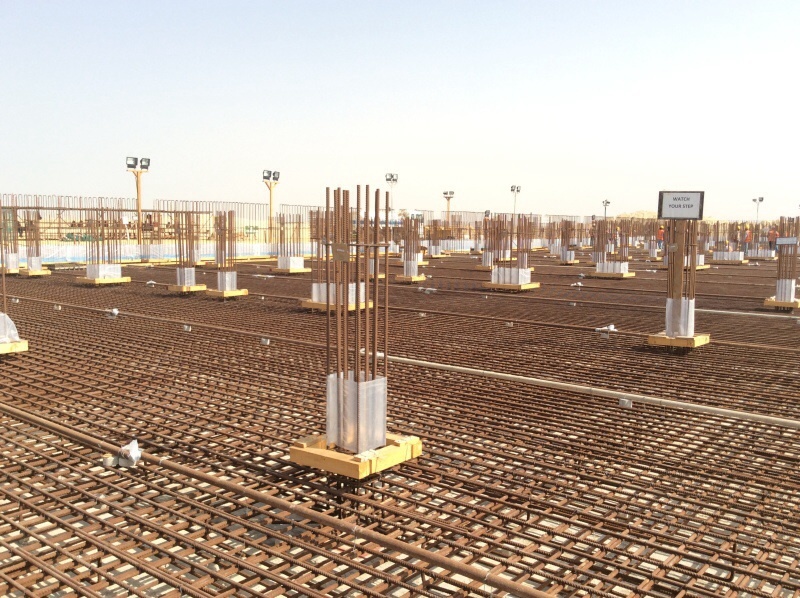Eng9876
Civil/Environmental
- Nov 30, 2004
- 15
This is a new thread based on this one that was closed. I felt that the answers given were not complete
Kickers aren't being used so much in construction today, a lot of new construction engineers are learning methods that can be more risky whereas taking a little extra time and setting a template (kicker) against each column/wall can pay back in dividends when saving re-work.
I was recently involved in a project with over 300 columns (using mainly unskilled labour in the middle east), with not one single cover or steel/column alignment issue, how many people can say that?
Why?... we used kickers.
What are kickers?:
A kicker is a small concrete plinth 50-150mm (2"-6") in height placed around a column base in order for you to quickly start your next stage column pour - it sets out the alignment pre-pour rather than post-pour (because if you need to move things, you can do it there and then). It is usually cast with the floor, pad or raft foundation. Construction can be fiddly/slows concreting for the first stage foundation slightly, but lost time is usually made up in time at the column/wall erection stage (if you have crews that know what they are doing).
Having a kicker you can physically see what's not right both in terms of cover and by looking along the kicker bases gives a quick visual indication of what needs to be moved. Obviously your surveyor would set-up a local grid to set these things out. It is easier to look along a straight edge of columns than it is a long string line with wavy 32mm reinforcement starter bars (which are usually placed where they can due to base steel configuration).
The reason why we have column and wall kickers are as follows:
From Checking Engineers Perspective:
For Having a Kicker - Pro's:
1, You can see any column or wall alignment issues immediately, fix any grid problems straight away(Once the concrete is cast and steel alignment problems exist, you don't have to cut the steel, just move it before you pour).
2. Makes the next stage construction (columns and walls) much faster as you only have to butt up your formwork against the kicker (alignment is already done).
3. Gives additional level(concrete elevation) guides as well as screed rails therefore providing better elevation control.
4. Reduces the amount of joints in the concrete. (you only have one joint where a second stage kicker would give you two. - NOT GOOD!)
For having a kicker - Cons:
1. Slower (INITIAL) stage pouring, but less risky. Slightly more fiddly initial construction for carpenters - this is however made up for at the next stage of construction.
2. Has to be done right - a finishing team must know what they are doing, if they mess up, concrete re-work will slow progress down. (use experienced concrete finishers - which you would do anyway).
From the contractors Perspective:
For not having a kicker - Pros:
1. Faster (INITIAL)construction, but risky. (however, many contractors cast a kicker at the second stage but this increases the number of joints in the concrete WHICH IS NOT GOOD). you will lose this time easily with all the re-work.
For not having a Kicker - Cons:
1. Any mistakes in the steel reinforcement could prove costly, whole gridlines in the wrong location may involve structural engineering to fix.
2. Cover issues may need re-work.
3. Increases the amount of joints in the concrete.
4. Once the concrete is poured and has set, mistakes require costly rework and potential structural engineering.
It is always best to have a kicker, you can see any alignment or cover issues straight away and fix them. Any time lost through making kickers is always made up at the next stage. You simply butt up your formwork against the kicker and plumb down for verticality. (don't forget your top column alignment.)
Not having a kicker is risky, best to take your time and get it right. Don't use inexperienced crews for concrete finishing, this is an added risk (and re-work) factor you don't need.
Kickers aren't being used so much in construction today, a lot of new construction engineers are learning methods that can be more risky whereas taking a little extra time and setting a template (kicker) against each column/wall can pay back in dividends when saving re-work.
I was recently involved in a project with over 300 columns (using mainly unskilled labour in the middle east), with not one single cover or steel/column alignment issue, how many people can say that?
Why?... we used kickers.
What are kickers?:
A kicker is a small concrete plinth 50-150mm (2"-6") in height placed around a column base in order for you to quickly start your next stage column pour - it sets out the alignment pre-pour rather than post-pour (because if you need to move things, you can do it there and then). It is usually cast with the floor, pad or raft foundation. Construction can be fiddly/slows concreting for the first stage foundation slightly, but lost time is usually made up in time at the column/wall erection stage (if you have crews that know what they are doing).
Having a kicker you can physically see what's not right both in terms of cover and by looking along the kicker bases gives a quick visual indication of what needs to be moved. Obviously your surveyor would set-up a local grid to set these things out. It is easier to look along a straight edge of columns than it is a long string line with wavy 32mm reinforcement starter bars (which are usually placed where they can due to base steel configuration).
The reason why we have column and wall kickers are as follows:
From Checking Engineers Perspective:
For Having a Kicker - Pro's:
1, You can see any column or wall alignment issues immediately, fix any grid problems straight away(Once the concrete is cast and steel alignment problems exist, you don't have to cut the steel, just move it before you pour).
2. Makes the next stage construction (columns and walls) much faster as you only have to butt up your formwork against the kicker (alignment is already done).
3. Gives additional level(concrete elevation) guides as well as screed rails therefore providing better elevation control.
4. Reduces the amount of joints in the concrete. (you only have one joint where a second stage kicker would give you two. - NOT GOOD!)
For having a kicker - Cons:
1. Slower (INITIAL) stage pouring, but less risky. Slightly more fiddly initial construction for carpenters - this is however made up for at the next stage of construction.
2. Has to be done right - a finishing team must know what they are doing, if they mess up, concrete re-work will slow progress down. (use experienced concrete finishers - which you would do anyway).
From the contractors Perspective:
For not having a kicker - Pros:
1. Faster (INITIAL)construction, but risky. (however, many contractors cast a kicker at the second stage but this increases the number of joints in the concrete WHICH IS NOT GOOD). you will lose this time easily with all the re-work.
For not having a Kicker - Cons:
1. Any mistakes in the steel reinforcement could prove costly, whole gridlines in the wrong location may involve structural engineering to fix.
2. Cover issues may need re-work.
3. Increases the amount of joints in the concrete.
4. Once the concrete is poured and has set, mistakes require costly rework and potential structural engineering.
It is always best to have a kicker, you can see any alignment or cover issues straight away and fix them. Any time lost through making kickers is always made up at the next stage. You simply butt up your formwork against the kicker and plumb down for verticality. (don't forget your top column alignment.)
Not having a kicker is risky, best to take your time and get it right. Don't use inexperienced crews for concrete finishing, this is an added risk (and re-work) factor you don't need.



